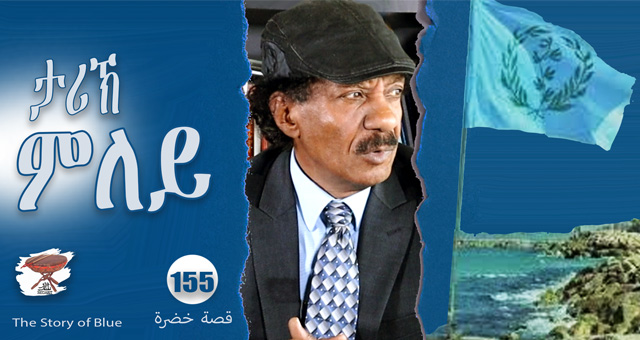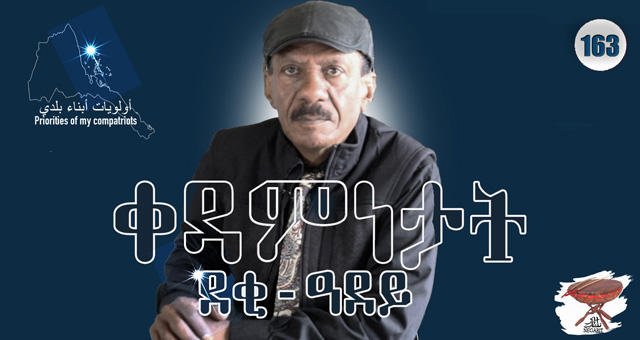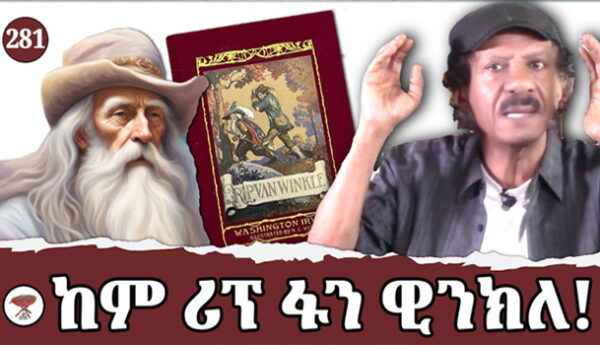The Story of the #BlueEritrea Flag
Today, I hope the restless would stay calm as I narrate a basic history of the Eritrean flag–the significance of our AwlieE, meley, HKhedra. I realize some people may have an opposing view, or to believe a contrary narration; it’s fine provided the counter narration is based on knowledge not on ignorance or bias. Some people adamantly reject views that are contrary to their perception and they argue in a vacuum, with so-much certainly. I will try to present the suppressed narration. And my presentation in Negarit 155 is based, mainly on an article which I wrote about 20 years ago (Linked below).
Between 1892-1941 Eritrea hoisted the Italian flag, and after the defeat of Fascist Italy by the Allies in WWII, Eritrea was taken over by the British military administration. Thus, the Italian flag was replaced by the Union Jack which was hoisted until 1952.
- Under the British Military Administration, the Pro-Italia party waved the Italian flag; a few opted for a British mandate and waved the Union Jack; the Unionists waved the Ethiopian flag; and the RabiTa, which was the only party that had an Eritrea centered vision, had a national flag, and lyrics:
Hamlay eyyu gonna, qeyH kenafere, Alemey dldl mizan ab maakela! Aslamay Kstanay bHade Temire, hagerey shewitey metset nqebela…English translation of the Tigrinya song:
Green is its sides, red is its lips
my symbol of equality and the scale it huddles
Uniting as one Muslims and Christiansmy lush nation is coming, let’s receive it together.
Soon after, the Rabita cofounded the Independence block and included Ibrahim Sultan, Ras Tessema, Abdulkadir Kebire, Weldeab Weldemariam and a few other notable politicians of the time.Meantime, regional and international powers planned to partition Eritrea and annex its parts to Sudan and Ethiopia. Eritreans found themselves at a crossroad: either to be partitioned between Sudan and Ethiopia, or unconditionally united with Ethiopia.
Coat of Arms (fascia and olive branches)
The Italian colonial Eritrean coat of arms 1936 -1941 had olive branches hugging the Fascia (symbol of the fascists) and a symbol of the sea—the olive branches were not new to Eritrea. Later, the British removed the olive branches and fascia, and replaced it with a crown hinting at the plan to put Eritrea under the Ethiopian crown of Haile Selassie.
- In the early fifties when a national symbol was needed, several flag designs competed, including one by the late Sheikh Omer Akito and another by Degiat Beyene Zahlay (both are mainly based on oral history and not documented reference is available. But it’s widely believed that the Blue Eritrean flag was designed by Eritrean parliamentarians and was adopted after a heated debate between all the 68 founding members of the Eritrean Council and agreed upon. Here, it’s important to note that the olive branches predate the formation of the UN—the parliamentarians knew about the olive branches before the UN was created—maybe the UN copied the Eritrean Blue flag not the other way around.
Eritrean Nationalism
To this day, the blue flag symbolizes the agreement that Eritreans unanimously reached, It’s the only legitimate symbol of Eritrean nationalism. It was the symbol of the struggle for justice, peace and freedom that still rages on.
- The Blue Eritrean Flag was passionately referred to as Khedra,in Tigrayit, and awliEey or Meley in Tigrinya—the national flag, the Blue Flag. Towards the end of the 1950s Emperor Haile Selassie began to openly violate and abolish the federal arrangement: he dissolved the Eritrean parliament, outlawed the Eritrean flag, lowered it and hoisted the Ethiopian flag in its place, and militarily occupied Eritrea. The lowering of the flag, the abolition of the constitution and the abolishing of Arabic-Tigrinya work and teaching languages, and replacing it with Amharic as a national language, sparked the long and arduous armed Eritrean struggle for self-determination. In reaction to that violation, Mohammed Said Naud, Saleh Eyay and their colleagues established the Eritrean Liberation Movement, (Haraka,Mahber shewAte) in port Sudan as a peaceful grassroots movement. In 1960 Eritrean students and professional formed the Eritrean Liberation Front in Cairo. And on September 1, 1961, Hamid Idris Awate started the Armed Struggle. All national organizations rallied around the blue Eritrean flag. In the sixties, it was very common around old strongholds of the Unionist party to see the Ethiopian flag revered. Though not required by law, the Ethiopian flag was carried in funeral procession and hoisted in venues of weddings and other public ceremonies. Bulls were wrapped in the Ethiopian flag on their way to be killed for a feast or a wedding. In a book he wrote, Shaleqa Dawit stated that Eritreans felt more Ethiopian than proper Ethiopians.
On the other hand, nationalist Eritreans brought the outlawed blue Eritrean flag from its hiding just to look and pay homage to it. Occasionally, in a very secretive ritual, parents showed the flag to their children so that they do not forget it. They told them that the Eritrean flag was their true symbol and not the occupational flag that Haile Selassie forcefully imposed on Eritreans.
The propaganda of the Unionist Party aggressively targeted the blue flag. To them, it was the “flag of the United Nations.” While the Ethiopian flag was elevated to a divine status, the Eritrean flag was portrayed as one belonging to the Bandits and Arab sellouts who betrayed their “Mother Ethiopia,” and want to separate the child (Eritrea) from its mother (Ethiopia). It was difficult for many who grew up feeding on this type of propaganda to come to terms with the fact that the blue Eritrean flag was decided and approved by the Eritrean founding fathers, by the first ever elected body of legislators that Eritrea ever produced.
- Furthermore, all Eritrean parties that represented the entire social and political forces of the country, including the pan-Ethiopianist Union party, participated in the negotiations and accepted the flag as a unifying symbol of Eritreans.On September 1, 1961, the national hero Hamid Idris Awate resurrected the blue flag that the unionists tried to bury in collaboration with Haile Selassie. He raised it high and started the long journey to reclaim a hoisting ground for it in all parts of Eritrea. Singers and poets have sung for the blue flag that represented Eritrea and its future; the people rallied behind it and the fire of nationalism was re-kindled representing the dreams of all Eritrean nationalists and patriots. It was the magnet that pulled all Eritreans together. Around 1973, the last remaining unionists were defeated. Almost in unison, Eritreans gave their allegiance to the true Eritrean flag. United under that banner, by 1977, Eritreans had liberated their country except for Asmara, Massawa, Asseb, and a negligible number of other Ethiopian army garrisons.
In its organizational congress in 1977, just a few years after all patriotic forces rallied behind the blue flag, the EPLF perplexed Eritreans by coming up with a new flag inspired by the leftists of the era and claimed it was an organization “banner”. Not many believed the reasoning. The EPLF flag had three triangles: blue, red, and green, and a yellow star in the red triangle. And the residue of that decision is the damage that inflicted the Eritrean psyche and unity; it’s still damaging the Eritrean social fabric. A big chunk of Eritreans believes the EPLF launched what it called its organizational “banner” with an intention to erase the blue flag.
- Three years later, the EPLF attacked the ELF in collaboration with the Ethiopian TPLF whose banner resembled that of the EPLF—with a blessing of Saudi Arabia and Jaafer Numeir’s Sudan. The ELF was militarily defeated and pushed out of Eritrea and into Sudan. As a result, the ELF disintegrated into several small splinter groups, one of which was known as SAGEM. In the eighties, a division of SAGEM led by Ibrahim Toteel, (in jail since 2013), Zemehret Yohannes (PFDJ senior official) and Gergis Tesfamichael (PFDJ minister). The branch they led merged with the EPLF and the EPLF grudgingly reinstated the blue flag. Thereafter, until Independence Day in 1991, both the blue flag and the EPLF banner were hoisted side by side.
Starting in 1991, after the independence of Eritrea, both flags were merged to form a shabbily designed combination of a tasteless flag with uneven triangles where the blue flag, now changed into a triangle, was stitched to the bottom of the EPLF “banner.” That combination flag was promoted with a slogan “Free Eritrea”, and printed on T-Shirts, posters, and stickers, and became the de-facto flag of the EPLF government. It was hoisted until 1993, the time the referendum for the self-determination of Eritrea was carried out.
- That shabby flag was scrapped after the referendum when the independence of Eritrea was officially declared. However, the PFDJ came up with yet another flag. This time, it came with a yellow olive branch on a red triangle, and two triangles of Blue and Green, a copy of what was deceivingly introduced in 1977 as an “organizational banner”, only this time, the yellow star, like that of china, was not appropriate in a post Berlin-wall world; they replaced the star with the olive branches of the original Eritrean flag. They only changed the natural green olive branches into yellow, the color of dead leaves.
The PFDJ Constitution
Officially, according to the PFDJ’s drafted but unimplemented constitution, the present flag is transitional; it unequivocally states that the National Assembly will make the final approval of the design of the flag. However, in Article 4 of the unimplemented PFDJ constitution, in the part that deals with “National Symbols”, article 1 reads like a fait accompli statement: “1. The Eritrean Flag shall have green, red and blue colors with golden olive leaves. The detailed description of the Flag shall be determined by law.”
As of now, more than three decades after independence, Eritrea doesn’t have an elected Assembly, and the unelected Assembly has not met for almost two decades after it did to condemn the G15 who are languishing in jail for twenty years with many others. Funnily, a member of the PFDJ central committee wondered if he was a member when I asked him about some issues. He has forgotten he was one!
The PFDJ didn’t explain why the flag was detailed for approval while the National Anthem and the designing of the Coat of Arms were left for the future National Assembly to decide upon.
- The PFDJ had a well-outlined vision on how to erase the memory of the blue flag from the Eritrean collective memory, to erase the flag that ignited Eritrean nationalism. The haphazard partisan decision to redesign the flag has caused a great deal of moral and psychological damage and a serious political polarization between Eritreans. On October 27 of 2001, when Mesfin Hagos was a guest speaker at a London meeting, the organizers displayed the shabby PFDJ’s flag of 1991 in on the wall behind the panelists’ seats. PFDJ supporters who don’t even know the history of the “Changing symbols of Eritrea” were quick to condemn him for sitting under “the flag that was designed in Mekele.” Dimtsi Hafash, as usual, the official Eritrean government radio roared: “The flag of gthe traitors”. The entire PFDJ operatives considered that a treason. Also, an article in the government Website, org (tired and closed) read: “The flag was a combination of the EPLF flag and the flag of the [Eritrean] groups that work with the Weyane.” In a 2003 demonstration in Washington DC, PFDJ supporters called it the flag of Torabora, after a famous mountains where the USA was waging war against the Taliban and Osama Binladen.Some Eritrean didn’t have the chance to be acquainted with the blue flag properly; but others have followed the evolution of the Eritrean symbols since they were born.
The PFDJ is neither qualified to choose the symbols of Eritrea nor credible enough to lecture Eritreans on the virtues of a flag.
Symbols are of great psychological and moral value through which affinities and allegiances to an idea or an entity are expressed. People need symbols that reflect their identity, their aspirations, and values. And they carry bad memories of the symbols of colonization or occupation. That is why the Ras Teffarian bandanas and headbands irritates many Eritreans. It is the flag that they consider the symbol of Ras Tefferi, whom they consider god. Personally, I always hid my liking of Reggae music, specially of Bob Marley. Many Eritreans do not like to be reminded of the untold sufferings and atrocities committed under “Ras Tefferi (Haile Selassie)” and that flag.
Ref:




Awate Forum